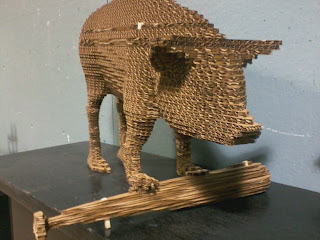


Digital Applications in Sculpture Computer Modeling for Sculpture Projects












 Exercise n1: The idea of notches was interesting, it introduced me to the laser printing process. Although it opens a wide variety of possibilities, it provided a pretty basic and rigid type of structure.
Exercise n1: The idea of notches was interesting, it introduced me to the laser printing process. Although it opens a wide variety of possibilities, it provided a pretty basic and rigid type of structure. Exercise n2: This was a very simple, yet extremely useful approach to laser cutting. It's perfect for creating armatures, you can cover it with plaster, epoxy, aqua-resin, etc. It will provide a very solid and compact base to work.
Exercise n2: This was a very simple, yet extremely useful approach to laser cutting. It's perfect for creating armatures, you can cover it with plaster, epoxy, aqua-resin, etc. It will provide a very solid and compact base to work. Exercise n3: This process is a little more complicated, I chose to work with the cutyourownribs and massiveunroll scripts. All you need to do is type in your material thickness and the script pretty much cuts it out for you. Then you use the massiveunroll script to lay out your ribs and it will even number them for you, which is very convenient. This approach requires more work but also lowers the amount of material needed, which means it's a lighter armature and more appropriate for large structures. Very useful knowledge!
Exercise n3: This process is a little more complicated, I chose to work with the cutyourownribs and massiveunroll scripts. All you need to do is type in your material thickness and the script pretty much cuts it out for you. Then you use the massiveunroll script to lay out your ribs and it will even number them for you, which is very convenient. This approach requires more work but also lowers the amount of material needed, which means it's a lighter armature and more appropriate for large structures. Very useful knowledge!

 For my final project, I chose to use my FDM model. I enlarged it to fit the ULS laser, although they decided it would be quicker to print with the beam. Six different 1/4 inch dowels were used to hold it together. Many of the contours needed to be fixed before printing. Overall, I am happy with the result, although I wish that they had not rotated the cardboard when they printed it, as this made the corrugation irregular.
For my final project, I chose to use my FDM model. I enlarged it to fit the ULS laser, although they decided it would be quicker to print with the beam. Six different 1/4 inch dowels were used to hold it together. Many of the contours needed to be fixed before printing. Overall, I am happy with the result, although I wish that they had not rotated the cardboard when they printed it, as this made the corrugation irregular.
















SCPT 250:
This course explores the relationship between digital tools and sculptural practice. Lectures and hands-on activities are supplemented by 2-D vector based programs, digital photography software and 3-D modeling programs. Students learn how to use the computer as a design tool for sculpture and to prepare files for various outputs.
SCPT 450:
Students explore their own personal visions using digital tools and computer software programs designed for the development of 3-D forms, spaces, objects, sites and processes. Students develop a critical basis for the evaluation of their use and explore the possibilities and implications of digital tools and processes.
Professor _ Andrew F. Scott
afscott@scad.edu